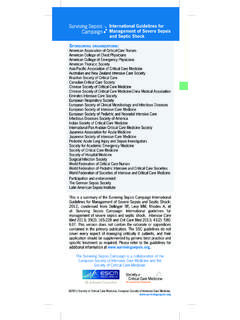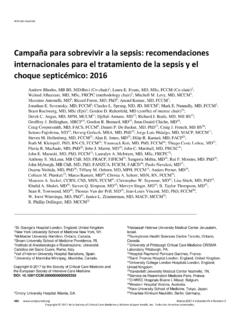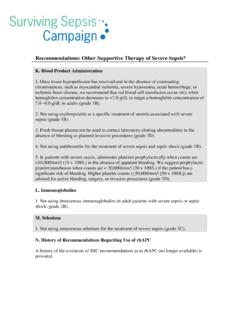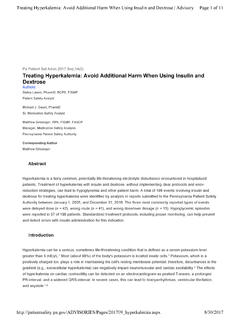Transcription of 3-Hour Bundle - survivingsepsis.org
1 3-Hour Bundle 1. Measure Lactate Level Background Hyperlactatemia is typically present in patients with severe sepsis or septic shock and may be secondary to anaerobic metabolism due to hypoperfusion or other complex factors. The prognostic value of raised blood lactate levels has been well established in septic shock patients[1], particularly if the high levels persist.[2,3] In addition, blood lactate levels have been shown to have greater prognostic value than oxygen-derived variables.[4] Obtaining a lactate level is essential to identifying tissue hypoperfusion in patients who are not yet hypotensive but who are at risk for septic shock. Limitations The interpretation of blood lactate levels in septic patients is not always straightforward. A number of studies have suggested that elevated lactate levels may result from cellular metabolic failure in sepsis rather than from global hypoperfusion.
2 Elevated lactate levels can also result from decreased clearance by the liver. Although blood lactate concentration may lack precision as a measure of tissue metabolic status, elevated levels in sepsis support aggressive resuscitation. Implications Given the high risk for septic shock, all patients with elevated lactate >4 mmol/L (36 mg/dL). enter the early goal-directed therapy portion of the 6-Hour Septic Shock Bundle , regardless of blood pressure. Mortality is high in septic patients with both hypotension and lactate 4 mmol/L. ( percent). Mortality is also increased in severely septic patients with hypotension alone ( percent) and lactate 4 mmol/L alone (30 percent).[5] This approach is consistent with the trial that established the value of early goal-directed therapies.
3 [6]. Turnaround Time Lactate levels must be available in your institution with rapid turnaround time (within minutes). to effectively treat severely septic patients. An arterial blood gas analyzer located in the clinical laboratories usually satisfies this requirement. However, any means of rapid turnaround time is acceptable. In some cases, it will be essential for hospitals to invest in adequate equipment in order to meet present standards of care for septic patients. The technique of obtaining lactate by venipuncture typically carries a 24- to 48-hour turnaround time and will not be suitable to care for septic patients. This technique also requires special collection conditions, such as without the use of tourniquet, which will likely hinder proper clinical care. 3-Hour Bundle Arterial vs.
4 Venous Lactate The question has been raised several times as to whether an arterial or venous lactate sample is required. While there is no consensus of settled literature on this question, an elevated lactate of any variety is typically abnormal and must be explained. Either collection is appropriate for Bundle compliance. Lactate elevations may be influenced by other conditions such as a variety of medications, hepatic insufficiency, or hyperlactatemia due to primarily cardiac causes of hypoperfusion. Grading the Evidence he use of lactate as a method to detect severe sepsis and septic shock and as a T. rationale for further therapies was evaluated as part of the larger recommendation on initial resuscitation in the 2012 Surviving Sepsis Campaign Guidelines. There, the guidelines committee recommended the protocolized, quantitative resuscitation of a patient with sepsis-induced shock, defined as tissue hypoperfusion (hypotension persisting after initial fluid challenge or blood lactate concentration equal to or greater than 4 mmol/L).
5 Evidence Grade 1C: This is a strong recommendation for care based on a number of qualitative considerations. C level evidence generally derives from randomized control trials with certain limitations or very well-done observational or cohort studies. he strategy of clearing lactate to normal values was also assessed in the 2012 Surviving T. Sepsis Campaign Guidelines. The Campaign suggests targeting resuscitation to normalize lactate in patients with elevated lactate levels as a marker of tissue hypoperfusion. Evidence Grade 2C: This is a suggestion for care based on a number of qualitative considerations. C level evidence generally derives from randomized control trials with certain limitations or very well-done observational or cohort studies [7]. References 1. W eil MH, Afifi AA.
6 Experimental and clinical studies on lactate and pyruvate as indicators of the severity of acute circulatory failure (shock). Circulation. 1970;41:989-1001. 2. Vincent JL, Dufaye P, Berre J, et al. Serial lactate determinations during circulatory shock. Critical Care Medicine. 1983;11:449-451. 3. Friedman G, Berlot G, Kahn RJ, et al. Combined measurements of blood lactate concentrations and gastric intramucosal pH in patients with severe sepsis. Critical Care Medicine. 1995;23:1184-1193. 4. Bakker J, Coffernils M, Leon M, et al. Blood lactate levels are superior to oxygen derived variables in predicting outcome in human septic shock. Chest. 1991;99:956-962. 5. Focht A, Jones AE, Lowe TJ. Early goal-directed therapy: improving mortality and morbidity of sepsis in the emergency department.
7 Jt Comm J Qual Patient Saf. 2009;35:186-91. 6. Rivers E, Nguyen B, Havstad S, et al. Early goal-directed therapy in the treatment of severe sepsis and septic shock. New England Journal of Medicine. 2001;345:1368-1377. 7. Jones AE, Shapiro NI, Trzeciak S, et al. Lactate clearance vs central venous oxygen saturation as goals of early sepsis therapy: a randomized clinical trial. JAMA. 2010 Feb 24;303(8):739-746. Content adapted extensively from: Vincent JL, Gerlach H. Fluid resuscitation in severe sepsis and septic shock: An evidence-based review. Critical Care Medicine. 2004;32(11):(Suppl.)S451-S454. Dellinger RP, Levy MM, Rhodes A, et al. Surviving Sepsis Campaign: International guidelines for management of severe sepsis and septic shock: 2012. Critical Care Medicine. 2013 Feb;41(2):580-637.
8 3-Hour Bundle TIPS. 1. I f serum lactate is not rapidly available in your institution, invest in equipment to make rapid assessment possible. This should be presented to hospital and laboratory administration as a present standard of care. 2. C. reate a standardized protocol to manage severe sepsis that includes measurement of lactate. 3. I nclude a prompt on arterial blood gas requisitions or physician order entry to prompt users to order lactate for suspected severe sepsis. 3-Hour Bundle 2. O. btain Blood Cultures Prior to Administration of Antibiotics Related Measures Timing of Blood Cultures Background The incidence of sepsis and bacteremia in critically ill patients has been increasing in the past two decades.[8,9] Thirty percent to 50 percent of patients presenting with a clinical syndrome of severe sepsis or shock have positive blood cultures.
9 Therefore, blood should be obtained for culture in any critically ill septic patient. Collecting blood cultures prior to antibiotic administration offers the best hope of identifying the organism that caused severe sepsis in an individual patient. Failure to check blood cultures prior to antibiotic infusion will perhaps affect the growth of any blood borne bacteria and prevent a culture from becoming positive later. Collection Strategy Two or more blood cultures are recommended with at least one drawn percutaneously and one drawn through each vascular access device, unless the device was recently inserted (<48 hours).[1,2] In patients with suspected catheter-related infection, a pair of blood cultures obtained through the catheter hub and a peripheral site should be obtained simultaneously.
10 Cultures of other sites (preferably quantitative, where appropriate), such as urine, cerebrospinal fluid, wounds, respiratory secretions, or other body fluids that may be the source of infection should also be obtained before antimicrobial therapy.[2] If the same organism is recovered from both cultures, the likelihood that the organism is causing the severe sepsis is enhanced. In addition, if the culture drawn through the vascular access device is positive much earlier than the peripheral blood culture ( , >2 hours earlier), it may offer support that the vascular access device is the source of the infection.[3] Volume of blood may also be important.[4]. 3-Hour Bundle Indications Fever, chills, hypothermia, leukocytosis, left shift of neutrophils, neutropenia, and the development of otherwise unexplained organ dysfunction ( , renal failure or signs of hemodynamic compromise) are specific indications for obtaining blood for culture.















